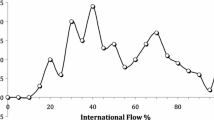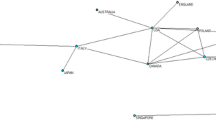Abstract
By transforming science into a vast single market for the exchange of research products, the globalization of scientific activity effects the mechanisms by which countries enter into mutual relations. It is no longer sufficient to conduct research jointly; research must also, and perhaps above all, be conducted within the strategic space of the network. In practice, the network takes the form of a cluster of nations and emerges in response to various determining factors or constraints. This does not, however, result in arbitrary criteria of association with the network: the distance from one country or group of countries able to play a regional or continental “governance” role, cultural or linguistic affinities, geographic proximity, the recognition of common interests, the existence of political agreements on cooperation are all grounds for linkage or association. In short, the geography of exchanges is changing before our eyes. This study describes as “world-science” marked by the collectivization of the centre, “centrality” being defined not by a national monopoly, but by the “hard core” of a transnational network, stratified on a continental or subcontinental basis.
Similar content being viewed by others
References and notes
D. C. Mowery, International Collaborative Ventures and the Commercialization of New Technologies,N. Rosenberg, R. Landau, D. C. Mowery (Eds),Technology and the Wealth of Nations, Stanford University Press, Stanford, California, 1992, p. 360.
Th. Schott, The World Scientific Community: Globality and Globalization.Minerva, XXIX (4) (Winter 1991) 440–462.
X. Polanco, Une science-monde: la mondialisation de la science européenne et la création de traditions scientifiques locales,Naissance et développement de la science-monde, Éditions la Découverte, Paris (1990) 10–52.
F. Braudel,Afterthoughts on Material Civilization & Capitalism, Johns Hopkins, 1977.
E. Schils, Center and Periphery,Center and Periphery, Essays in Macrosociology, University of Chicago Press, Chicago, 1975, 3–16.
M. Moravcsik, Technical Assistance and Fundamental Research in Underdeveloped Countries,Minerva, 2 (2) (Winter 1964) 197–209.
S. Dedijer, Underdeveloped Science in Underdeveloped Countries,Minerva, 2 (1) (Autumn 1963) 61–81.
Th. Schott, World Science: Globalization of Institutions and Participation,Science, Technology & Human Values, 18 (2) (Spring 1992) 196–208.
E. Schils, Reflections on Traditional Center and Periphery, and the Universal Validity of Science: The Significance of the Life of S. Ramanujan,Minerva, 29 (1991) 393–419.
Th. Schott, World Science: Globalization of Institutions and Participation,Science, Technology & Human Values, 18 (2) (Spring 1992) 196–208.
Th. Schott, The World Scientific Community: Globality and Globalization,Minerva, XXIX, (4) (Winter 1991) 440–462.
K. Polanyi,The Great Transformation, Beacon Press, Boston, 1944.
M. Carpenter,International Science Indicators — Development of Indicators of International Scientific Activity Using the Science Citation Index, report submitted to the National Science Foundation (Contract No. SRS 77-22770, Washington, D.C., 1979).
National Science Board,Science & Engineering Indicators — 1991, Government Printing Office, Washington, D.C., U.S., NSB 91-1, 1991.
A. Schubert, W. Glänzel, T. Braun, Scientometrics Datafiles. A Comprehensive Set of Indicators on 2649 Journals of 96 Countries in All Major Science Fields and Subfields, 1981–1985,Scientometrics, 16 (1989) 3–478.
J. Anderson et al., On-Line Approaches to Measuring National Scientific Output: A Cautionary Tele,Science and Public Policy, 15 (3) (1988) 53–161;L. Leydesdorff, Problems with the ‘Measurement’ of National Scientific Performance,Science and Public Policy, 15 (3) (1988) 149–152;D. Lindsey, Production and Citation Measures in the Sociology of Science: The Problem of Multiple Authorship,Social Studies of Science, 10 (1980) 145–162.
M. Callon, J.-P. Courtial, H. Penan,La scientométrie Presses universitaires de France, Paris, 1993.
M. Callon, J.-P. Courtial, H. Penan,.
H. F. Moed, R. E. De Bruin, A. J. Nederhof, R. J. W. Tijssen, International Scientific Cooperation and Awareness within the European Community: Problems and Perspectives,Scientometrics, 21 (1991) 291–311.
See, for example,R. J. W. Tijssen, H. F. Moed, Literature-based Statistical Analyses of International Scientific Co-operation: An Exploratory Case Study of the Netherlands, in:Science and Technology Indicators: Their Use in Science Policy and Their Role in Science Studies,A. F. J. Van Raan and al. (Eds), Leiden, DSWO Press (1989) 129–145;T. Luukkonen, O. Persson, G. Sivertsen, Understanding Patterns of International Scientific Collaboration,Science, Technology & Human Values, 17 (1) (1992) 101–126.
See, for example,Y. Okubo, J.-F. Miquel, International Collaboration in Basic Science, in:Indikatoren der Wissenschaft und Technik- Theorie, Methoden, Anwendungen,P. Weingart and al. (Eds), Campus, Forschung (1991) 49–71;M. Leclerc, J.-F. Miquel, O. Okubo, L. Frigoletto, The Scientific Cooperation Between Canada and the European Community,Science and Public Policy, (19) 1, (1992) 15–24.
T. Luukkonen, O. Persson, G. Sivertsen, Understanding Patterns of International Scientific Collaboration,Science, Technology & Human Values, 17 (1) (Winter 1992) 101–126;F. Narin, E. S. Whitlow,Measurement of Scientific Cooperation and Authorship in CEC-related Areas of Science, Vol. 1, Brussels, Commission of the European Communities (EUR 12900 EN, 1990).
J. D. Frame, M. P. Carpenter, International Research Collaboration,Social Studies of Science, 9 (1979) 481–497;A. Schubert, T. Braun, International Collaboration in the Sciences, 1981–1985,Scientometrics, 19 (1–2) (1990) 3–10.
J. Sigurdson, Internationalising Research and Development in Japan,Science and Public Policy, 19 (3) (1992) 134–144.
Th. Schott International Influence in Science: Beyond Center and Periphery,Social Science Research, 17 (1988) 219–238.
T. Luukkonen, O. Persson, G. Sivertsen, Understanding Patterns of International Scientific Collaboration,Science, Technology & Human Values, 17 (1) (Winter 1992) 101–126.
M. J. Moravcsik, The Coverage of Science in the Third World: The ‘Philadelphia Program’,L. Egghe, R. Rousseau (Eds),Informetrics, 87–88, Elsevier Science Publishers, Amsterdam, 1988, 147–155.
UNESCO,Statistics on Science and Technology, Paris, October 1991.
G. Gerefi,The Pharmaceutical Industry and Dependency in the Third World, Princeton University, Princeton, New Yersey, 1983.
O. Kenichi,Triad Power: The Coming Shape of Global Competition, Free Press, New York, 1985.
P. Kennedy,The Rise and Fall of the Great Powers, Random House, 1987.
Ph. Mustar,Science et innovation: Annuaire raisonné de la création d'entreprises technologiques par les chercheurs en France, Paris, Economica, 1988.
European Parliament,Les progrés de la construction en science — Aperçu documentaire sur les principales activités du Parlement européen (Direction générale des études, July 1986–June 1987).
Ch. H. Davis, Th. O. Eisemon, Mainstream and Non Mainstream Scientific Literature in Four Peripheral Asian Scientific Communities,Scientometrics, 15 (1989) 215–239.
I. D. Duchacek, Multicommunal and Biocommunal Politics and Their International Relations,I. D. Duchacek, D. Latouche, G. Stevenson (Eds),Perforated Sovereignties and International Relations: Trans-Sovereign Governments, New York, Greenwood Press, 1988.
D. J. de S. Price,Little Science, Big Science, Columbia University Press, 1963.
Formal cooperation frameworks are increasingly appearing, binding countries that are, in some cases, on different continents. These frameworks are called «umbrella agreements»,M. D. Bloom,International Science and Technology Agreements: Their Use and Relevance, report prepared for the Royal Institute on Internaitonal Affairs, London, 1989, and apply to commercial accords as well as to multilateral research agreements between laboratories, to support for specific S & T research projects and so on.
E. Crawford, Denationalizing Science: The Context of International Scientific Pratise,Sociology of Science Yearbook, (16), Dordrecht, Kluwer, 1992.
Th. Schott International Influence in Science: Beyond Center and Periphery,Social Science Research, 29 (1991) 393–419.
M. Callon, Vers des archipels de la science,Science et Technologie, 4 (1991) 66–69.
D. J. de S. Price,Little Science, Big Science, Columbia University Press, 1963.
M. Callon, Vers des archipels de la science,Science et Technologie, 34 (1991) 66–69.
R. Reich, Who is Us?,Harvard Business Review, (March–April 1991) 77–88.
Author information
Authors and Affiliations
Rights and permissions
About this article
Cite this article
Leclerc, M., Gagné, J. International scientific cooperation: The continentalization of science. Scientometrics 31, 261–292 (1994). https://doi.org/10.1007/BF02016876
Received:
Issue Date:
DOI: https://doi.org/10.1007/BF02016876




